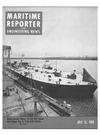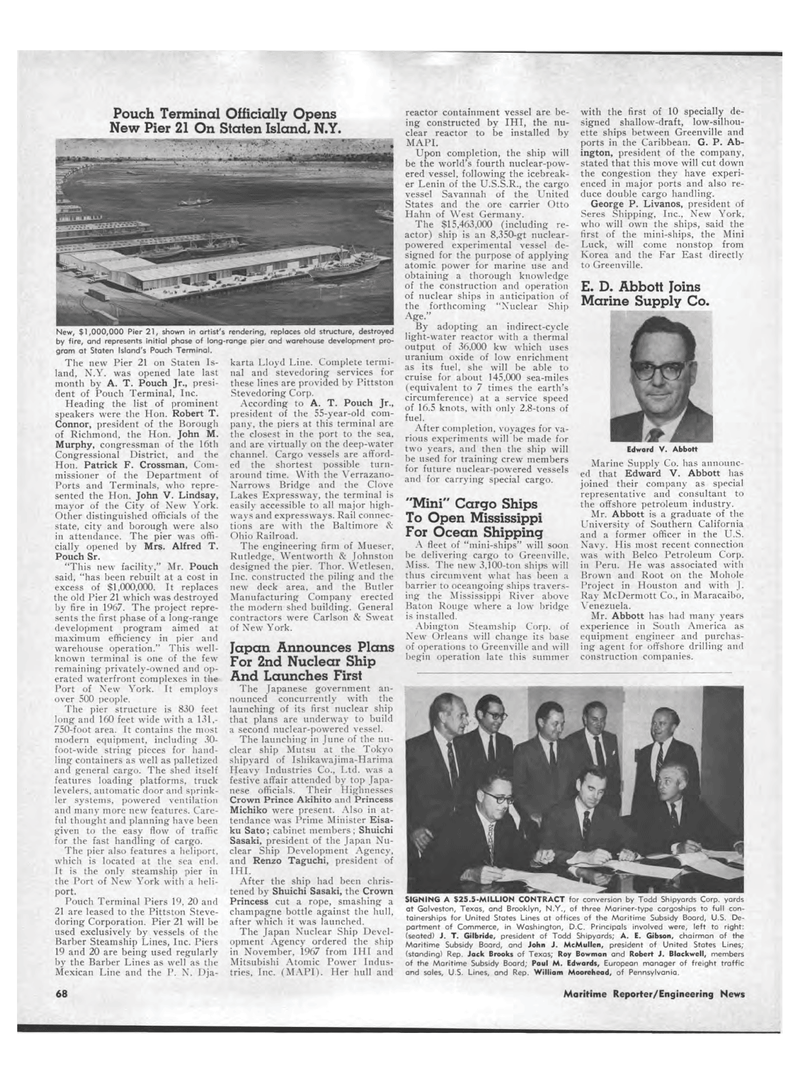
Page 64: of Maritime Reporter Magazine (July 15, 1969)
Read this page in Pdf, Flash or Html5 edition of July 15, 1969 Maritime Reporter Magazine
Pouch Terminal Officially Opens New Pier 21 On Staten Island, N.Y. New, $1,000,000 Pier 21, shown in artist's by fire, and represents initial phase of long gram at Staten Island's Pouch Terminal. The new Pier 21 on Staten Is-land, N.Y. was opened late last month by A. T. Pouch Jr., presi-dent of Pouch Terminal, Inc. Heading the list of prominent speakers were the Hon. Robert T. Connor, president of the Borough of Richmond, the Hon. John M. Murphy, congressman of the 16th Congressional District, and the Hon. Patrick F. Crossman, Com-missioner of the Department of Ports and Terminals, who repre-sented the Hon. John V. Lindsay, mayor of the City of New York. Other distinguished officials of the state, city and borough were also in attendance. The pier was offi-cially opened by Mrs. Alfred T. Pouch Sr. "This new facility," Mr. Pouch said, "has been rebuilt at a cost in excess of $1,000,000. It replaces the old Pier 21 which was destroyed by fire in 1967. The project repre-sents the first phase of a long-range development program aimed at maximum efficiency in pier and warehouse operation." This well-known terminal is one of the few remaining privately-owned and op-erated waterfront complexes in the Port of New York. It employs over 500 people. The pier structure is 830 feet long and 160 feet wide with a 131,-750-foot area. It contains the most modern equipment, including 30-foot-wide string pieces for hand-ling containers as well as palletized and general cargo. The shed itself features loading platforms, truck levelers, automatic door and sprink-ler systems, powered ventilation and many more new features. Care-ful thought and planning have been given to the easy flow of traffic for the fast handling of cargo. The pier also features a heliport, which is located at the sea end. It is the only steamship pier in the Port of New York with a heli-port. Pouch Terminal Piers 19, 20 and 21 are leased to the Pittston Steve-doring Corporation. Pier 21 will be used exclusively by vessels of the Barber Steamship Lines, Inc. Piers 19 and 20 are being used regularly by the Barber Lines as well as the Mexican Line and the P. N. Dja-rendering, replaces old structure, destroyed range pier and warehouse development pro-karta Lloyd Line. Complete termi-nal and stevedoring services for these lines are provided by Pittston Stevedoring Corp. According to A. T. Pouch Jr., president of the 55-year-old com-pany, the piers at this terminal are the closest in the port to the sea, and are virtually on the deep-water channel. Cargo vessels are afford-ed the shortest possible turn-around time. With the Verrazano-Narrows Bridge and the Clove Lakes Expressway, the terminal is easily accessible to all major high-ways and expressways. Rail connec-tions are with the Baltimore & Ohio Railroad. The engineering firm of Mueser, Rutledge, Wentworth & Johnston designed the pier. Thor. Wetlesen. Inc. constructed the piling and the new deck area, and the Butler Manufacturing Company erected the modern shed building. General contractors were Carlson & Sweat of New York. Japan Announces Plans For 2nd Nuclear Ship And Launches First The Japanese government an-nounced concurrently with the launching of its first nuclear ship that plans are underway to build a second nuclear-powered vessel. The launching in June of the nu-clear ship Mutsu at the Tokyo shipyard of Ishikawajima-Harima Heavy Industries Co., Ltd. was a festive affair attended by top Japa-nese officials. Their Highnesses Crown Prince Akihito and Princess Michiko were present. Also in at-tendance was Prime Minister Eisa-ku Sato; cabinet members ; Shuichi Sasaki, president of the Japan Nu-clear Ship Development Agency, and Renzo Taguchi, president of IHI. After the ship had been chris-tened by Shuichi Sasaki, the Crown Princess cut a rope, smashing a champagne bottle against the hull, after which it was launched. The Japan Nuclear Ship Devel-opment Agency ordered the ship in November, 1967 from IHI and Mitsubishi Atomic Power Indus-tries, Inc. (MAPI). Her hull and reactor containment vessel are be-ing constructed by IHI, the nu-clear reactor to be installed by MAPI. Upon completion, the ship will be the world's fourth nuclear-pow-ered vessel, following the icebreak-er Lenin of the U.S.S.R., the cargo vessel Savannah of the United States and the ore carrier Otto Hahn of West Germany. The $15,463,000 (including re-actor) ship is an 8,350-gt nuclear-powered experimental vessel de-signed for the purpose of applying atomic power for marine use and obtaining a thorough knowledge of the construction and operation of nuclear ships in anticipation of the forthcoming "Nuclear Shi]) Age." By adopting an indirect-cycle light-water reactor with a thermal output of 36.000 kw which uses uranium oxide of low enrichment as its fuel, she will be able to cruise for about 145,000 sea-miles (equivalent to 7 times the earth's circumference) at a service speed of 16.5 knots, with only 2.8-tons of fuel. After completion, voyages for va-rious experiments will be made for two years, and then the ship will be used for training crew members for future nuclear-powered vessels and for carrying special cargo. "Mini" Cargo Ships To Open Mississippi For Ocean Shipping A fleet of "mini-ships" will soon be delivering cargo to Greenville, Miss. The new 3,100-ton ships will thus circumvent what has been a barrier to oceangoing ships travers-ing the Mississippi River above Baton Rouge where a low bridge is installed. Aldington Steamship Corp. of New Orleans will change its base of operations to Greenville and will begin operation late this summer SIGNING A S25.5-MILLION CONTRACT for conversion by Todd Shipyards Corp. yards at Galveston, Texas, and Brooklyn, N.Y., of three Mariner-type cargoships to full con-tainerships for United States Lines at offices of the Maritime Subsidy Board, U.S. De-partment of Commerce, in Washington, D.C. Principals involved were, left to right: (seated) J. T. Gilbride, president of Todd Shipyards; A. E. Gibson, chairman of the Maritime Subsidy Board, and John J. McMullen, president of United States Lines; (standing) Rep. Jock Brooks of Texas; Roy Bowman and Robert J. Blackwell, members of the Maritime Subsidy Board; Paul M. Edwards, European manager of freight traffic and sales, U.S. Lines, and Rep. William Mooreheod, of Pennsylvania. with the first of 10 specially de-signed shallow-draft, low-silhou-ette ships between Greenville and ports in the Caribbean. G. P. Ab-ington, president of the company, stated that this move will cut down the congestion they have experi-enced in major ports and also re-duce double cargo handling. George P. Livanos, president of Seres Shipping, Inc., New York, who will own the ships, said the first of the mini-ships, the Mini Luck, will come nonstop from Korea and the Far East directly to Greenville. E. D. Abbott Joins Marine Supply Co. Edward V. Abbott Marine Supply Co. has announc-ed that Edward V. Abbott has joined their company as special representative and consultant to the offshore petroleum industry. Mr. Abbott is a graduate of the University of Southern California and a former officer in the U.S. Navy. His most recent connection was with Belco Petroleum Corp. in Peru. He was associated with Brown and Root on the Mohole I'roject in Houston and with J. Ray McDermott Co., in Maracaibo, Venezuela. Mr. Abbott has had many years experience in South America as equipment engineer and purchas-ing agent for offshore drilling and construction companies. 68 Maritime Reporter/Engineering News

 63
63

 65
65
